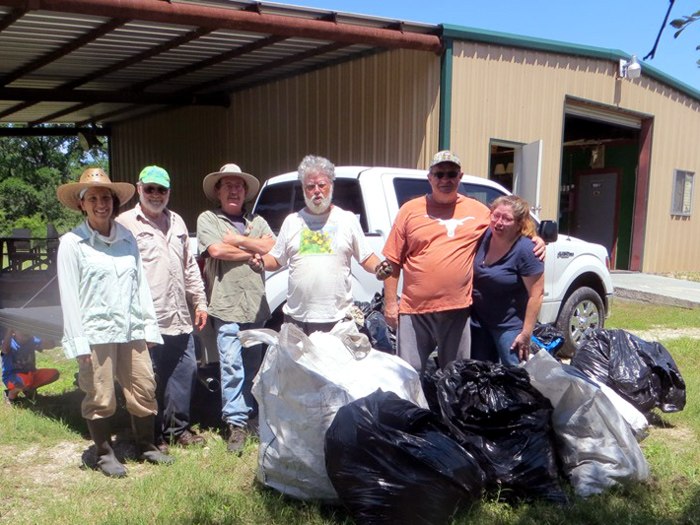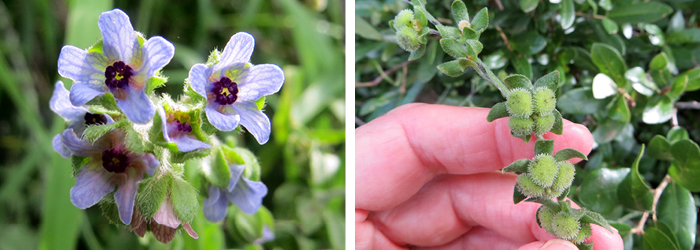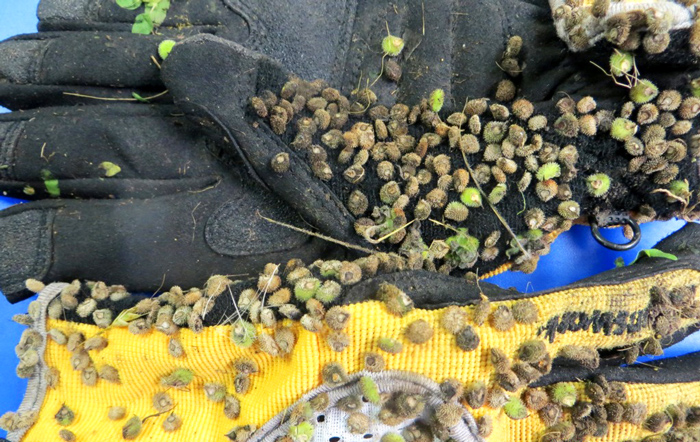Striking the First Blow

This team gathered to pull blue hound’s tongue, a new invasive plant, from a Texas ranch. Left to right: Andrea DeLong-Amaya, David Mahler, Bill Carr, Dick Davis, Dennis Johnston and Denise Johnston. PHOTO Minnette Marr
WHEN DENNIS AND DENISE JOHNSTON looked for a retreat away from Houston, having native landscapes to roam on was a priority so Dennis could hunt and Denise could fulfill a passion for Texas wildflowers. A 43-acre parcel near the tiny town of Oakalla in rural Burnet County fit the bill.
“There’s 6,000 acres across the street near northern Rocky Creek that are under one owner and hundred-acre ranches nearby, and everybody has cattle,” says Dennis, the park director for Harris County Precinct 4. “Wal-Mart and other stores are just 13 miles away, and some day all of that will reach us, but it hasn’t happened yet.”
The peace they’ve found on the spread they named Oak Valley Ranch after purchasing it in 2011 could last a long time. But Denise discovered a flowering plant there last spring that unexpectedly put their private getaway on the map. Known as blue hound’s tongue (Cynoglossum creticum), the leggy Mediterranean plant with blue or pink flowers was new to her and not in any guide books.
Denise’s determination to identify the plant eventually led her to Bill Carr, a botanist with the University of Texas at Austin Plant Resources Center, who visited the property in late May for a first-hand look.
His worries confirmed, Carr reached out the next day to Wildflower Center staff and other colleagues to organize a Saturday “pulling party” to remove the nuisance.
The center’s Land Steward, Dick Davis, was among staff to volunteer on short notice. “In my lifetime, I’ve seen places I love completely changed by invasive species,” says the Corpus Christi native, referring to exotic grasses that now cover most landscapes where natives once ruled around his hometown. “This was a rare chance to try to eliminate a plant that has reached Texas.”

Blue hound’s tongue (Cynoglossum creticum) has blue or pink flowers (left) and each flower produces four fruits, or nutlets, with a seed inside a shell coated with thorns (right). PHOTOS Minnette Marr
Leaving nothing to chance
A chief concern for those who hand-pulled the plant from around a barn, near some oak mottes and in cedar elm bottomland, was that the invasive would reach other ranchland still used for livestock. The long, hairy leaves of blue hound’s tongue contain toxic alkaline chemicals that can kill cows, horses and other herbivores that ignore the leaves’ bitter taste.
Livestock might turn to blue hound’s tongue on overgrazed land lacking other options, or when ranchers feed the livestock hay that inadvertently includes pieces of blue hound’s tongue leaves. Minnette Marr, the center’s plant conservationist and a third-generation Texan like Davis, says, “You don’t want to see that plant around because it’s still toxic even after it’s cut.”
The pulling party, which included the Johnstons, environmental consultant David Mahler, and the center’s Horticulture Director, Andrea Delong-Amaya, worked for three hours to remove much of the blue hound’s tongue present. The pulled plants filled the bed of Carr’s and Mahler’s trucks.
Working against the clock
The pulling party convened just 10 days after Carr’s visit because the botanists knew the invasive, which had never before been recorded in Texas, could be tough to eradicate. Blue hound’s tongue seedlings grow fast and bloom during their second spring. By late spring, each of their flowers produces four fruits, or nutlets, with a seed inside a shell coated with thorns.
The thorns mean business, causing skin infections in some livestock and more. Dr. George Yatskievych, curator and director of the Flora of Missouri Project at the Missouri Botanical Garden, has observed blue hound’s tongue specimens collected in three southwestern counties since it was first identified there in the 1970s. He likens the thorns to Velcro, and notes they can attach to most anything, including tires on farm equipment or cars — making it easier for the plant to spread.
On the plus side, blue hound’s tongue seeds only survive two to three years in the soil based on studies conducted in New Zealand and Australia, where it is on the alert list of 28 environmental weeds to eradicate. And, as Dennis Johnston notes, “the plant’s leaves have a glossy green look to them that stands out from others around them, and they come up out of the ground pretty easily.”

Gardening gloves covered with prickly nutlets show how easy it is for blue hound’s tongue to spread by hitching a ride. PHOTO Minnette Marr
Still, no one is being complacent about this invasive plant. The pulling party occurred late in the plant’s blooming season. Nutlets had already formed on some plants as a result, some of which had likely caught rides on the fur of rabbits, deer and other wildlife. Some of the invasive was also found near a culvert where rainwater could carry nutlets downstream.
The Johnstons hope to get local help to fight blue hound’s tongue in the Oakalla area early next spring. As Marr notes, “If we can get in there and really hit it hard for two or three years, that should make a big difference.”
Spreading the word about blue hound’s tongue is also important. Most land in Texas is owned by private landowners who would need to share Denise’s determination to identify what’s native and what’s not to keep an invasive like this at bay.
“I’m a former director of Jesse Jones Park and Nature Center in Humble, and a big fan of native prairies and landscapes for all the benefits they provide to wildlife and more,” Dennis says. “If blue hound’s tongue could be stopped here and now, before it spreads throughout Texas, I’d love to see that.”
To learn how to identify invasive plants and pests of Texas, consider online training or a local workshop provided by the Texas Invasives program overseen by the Wildflower Center.

